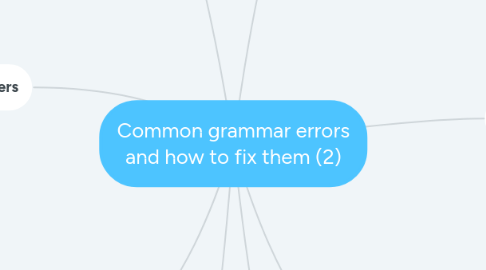
1. Adverbs
1.1. Adverbs are words that modify a verb, an adjective, or another adverb. They tell when, where, why, or under what conditions something happens or has happened.
1.2. Put the adverb next to the word it modifies. (e.g. Incorrect: It almost seems impossible to finish the brief by July. Correct: It seems almost impossible to finish the brief by July.)
1.3. Put adverbs at the beginning of sentences for emphasis or when you want to qualify the whole sentence. (e.g. Fortunately, no one was in the courtroom when the ceiling fell down.)
2. Modifiers
2.1. Misplaced modifiers
2.1.1. Occurs when you improperly separate a word, phrase, or clause from the word it describes. (e.g. "She almost sold all her used law books at the garage sale." The writer isn't trying to say that she almost sold all her used law books. The writer means to say, "She sold almost all her used law books at the garage sale."
2.2. Squinting modifiers
2.2.1. A modifier that might refer to a preceding or a following word. It creates confusion. The adverb might function perfectly in the sentence structure but the meaning might be ambiguous. (e.g. "Eric told his daughter when the meeting was over he would play with her." Correct: "Eric told his daughter he would play with her when the meeting was over.")
2.3. Dangling modifiers
2.3.1. A modifier dangles when the noun or pronoun to which a phrase or clause refers is in the wrong place or missing. (e.g. "Once edited and rearranged, Bill received an A+." Correct: "After editing and rearranging his law school paper, Bill received an A+.")
2.4. Awkward separations
2.4.1. An awkward separation creates confusion. (e.g. "Many students have, by the time they finish law school, interned for a judge." Correct: "By the time they finish law school, many students have interned for a judge.")
3. Problem Words and Pairs
3.1. e.g. bare/bear; affect/effect; accept/except; already/ all ready; all together/altogether; desert/dessert; its/it's; less/fewer; loose/lose; principal/principle; than/then; their/there/they're; whether/weather; your/you're
4. The Sentence Extra
4.1. Eliminate the unnecessary "that" in a string of clauses. (e.g. Incorrect: "The law clerk said that although she will draft the opinion, that no one will read it". Correct: "The law clerk said that although she will draft the opinion, no one will read it.")
4.2. Eliminate extra prepositions. (e.g. Incorrect: "But if this ever changing world in which we live in..." Correct: "But if this ever changing world in which we live...")
5. The Run-On Sentence
5.1. The conjunctive adverb run-on
5.1.1. e.g. "John Doe wrote the opinion. however, he never read it to the litigants." In this example, "however is the the conjunctive adverb separating two independent clauses. No semicolon or period precedes the conjunctive adverb "however". To fix this sentence, put a semicolon or a period after "opinion". Then put a comma after the conjunctive adverb. The example becomes: "John Doe wrote the opinion; however, he never read it to the litigants."
5.2. The no-punctuation run-on
5.2.1. e.g. "It's cold in the courtroom I should put on a jacket." There is no punctuation between the two independent clauses. To fix this sentence, put a semicolon or a period between the independent clauses. The example becomes: "It's cold in the courtroom; I should put on a jacket."
5.3. The comma-splice run-on
5.3.1. e.g. "It's cold in the courtroom, I should put on a jacket." A comma separates the two clauses. Fix this run-on sentence the same way as in Example 2.

